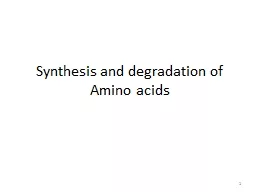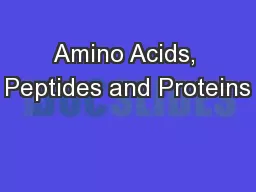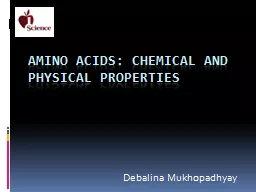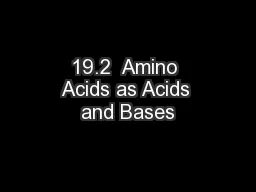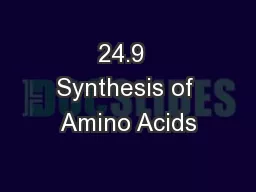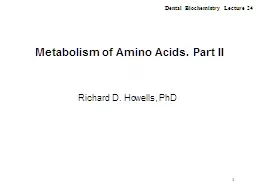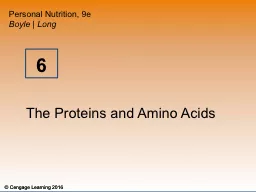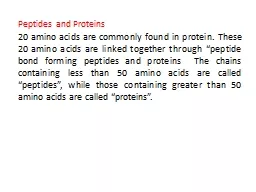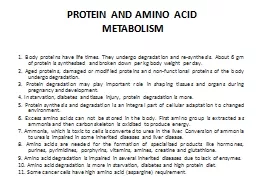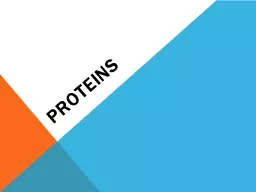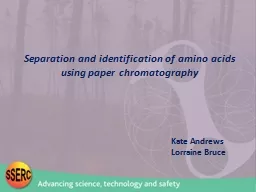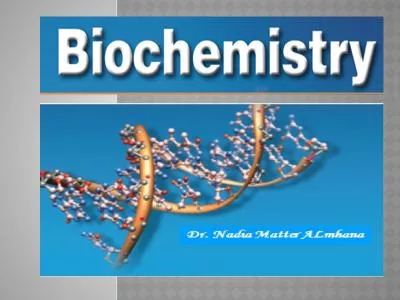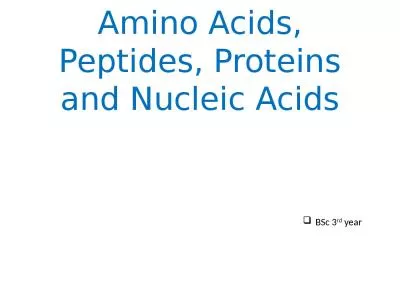PPT-Synthesis and degradation of Amino acids
Author : tatiana-dople | Published Date : 2020-04-03
1 Overview The catabolism of the amino acids involves Removal of αamino groups Breakdown of the resulting carbon skeletons The resulting compounds will be used
Presentation Embed Code
Download Presentation
Download Presentation The PPT/PDF document " Synthesis and degradation of Amino acid..." is the property of its rightful owner. Permission is granted to download and print the materials on this website for personal, non-commercial use only, and to display it on your personal computer provided you do not modify the materials and that you retain all copyright notices contained in the materials. By downloading content from our website, you accept the terms of this agreement.
Synthesis and degradation of Amino acids: Transcript
1 Overview The catabolism of the amino acids involves Removal of αamino groups Breakdown of the resulting carbon skeletons The resulting compounds will be used to form seven intermediate products . Codons. Prefixes, Suffixes and Vocabulary. Poly. = many. Peptide bond . =bond between two amino acids.. Anti. = against, opposite. Dehydration. = loss of water. Polypeptide. = long assembled string of amino acids.. CHAPTER 3, Part 1 . Amino Acids and Peptides . To know the structure and naming of all 20 protein amino acids. To know the structure and properties of peptides and the particularly the structure of the peptide bond.. Debalina. . Mukhopadhyay. . . Containing carbon, hydrogen, nitrogen, oxygen. . Building blocks of protein. . Contain Amino group (NH2+) , carboxyl . group . (COO-) , Alkyl group (R ) / H . . alpha carbon contains the functional groups.. When an amino acid with positive and negative charges is overall neutral in charge, it is said to be at its . isoelectric point (. pI. ). .. . Ball-and-stick model of glycine at its . pI. of 6.0.. Plants and bacteria produce all of their amino acids using NH. 4. +. and NO. 3. –. .. Humans can synthesize 9 of the 20 amino acids found in their proteins.. Nonessential amino acids are synthesized in the body, while essential amino acids must be obtained from diet.. Richard D. Howells, PhD. Dental Biochemistry Lecture 24. 2. Learning Objectives. To describe the urea cycle and its fundamental role in the excretion of nitrogen.. To . distinguish between . glucogenic. 6. 6.1 Differentiate . between essential amino acids and nonessential amino acids.. 6.2 List . the functions of protein in the body.. 6.3 List . the steps for protein digestion and absorption in the body. . Peptide bond formation. : . α-carboxyl group of one amino acid (with side chain R1) forms a covalent peptide bond with α-amino group of another amino acid . ( . with the side chain R2) by removal of a molecule of water. The result is : Dipeptide ( i.e. Two amino acids linked by one peptide bond). By the same way, the dipeptide can then forms a second peptide bond with a third amino acid (with side chain R3) to give . Protein. Builds and repairs body tissue. Provides some energy. There are 4 calories per gram of protein. Protein. Composed of chains of amino acids. Common Amino Acids. Alanine. Glycine. Isoleucine. Leucine. 2. Aged proteins, damaged or modified proteins and non-functional proteins of the body undergo degradation. . 3. Protein degradation may play important role in shaping tissues and organs during pregnancy and development.. . Amino . Acids are the building units of proteins. There are about 300 amino acids occur in nature. Only 20 of them enter in proteins synthesis.. . Structure of amino acids:. Four different . groups . u. sing paper chromatography. Kate Andrews. Lorraine Bruce. Unit 1 DNA and the Genome. 3 Control of gene expression. Separation and identification of amino acids using paper chromatography.. Cells and Proteins. imino. acid.” . Figure 5: Comparison of the secondary amino group found in proline with the primary amino group found in other amino acids such as alanine.. 2. Proline: . Proline differs from other amino acids in that its side chain and amino N form a rigid, five -member red ring structure (Figure 5). Proline, then, has a secondary (rather than a primary) amino group. It is frequently referred to as an “. BSc 3. rd. year . AMINO ACIDS. C. lassification of amino acids . Classification according to nature of side chain. PREPARATION OF AMINO ACIDS. 1. Gabriel Phthalimide synthesis. 2. Strecker’s synthesis.
Download Document
Here is the link to download the presentation.
" Synthesis and degradation of Amino acids"The content belongs to its owner. You may download and print it for personal use, without modification, and keep all copyright notices. By downloading, you agree to these terms.
Related Documents

